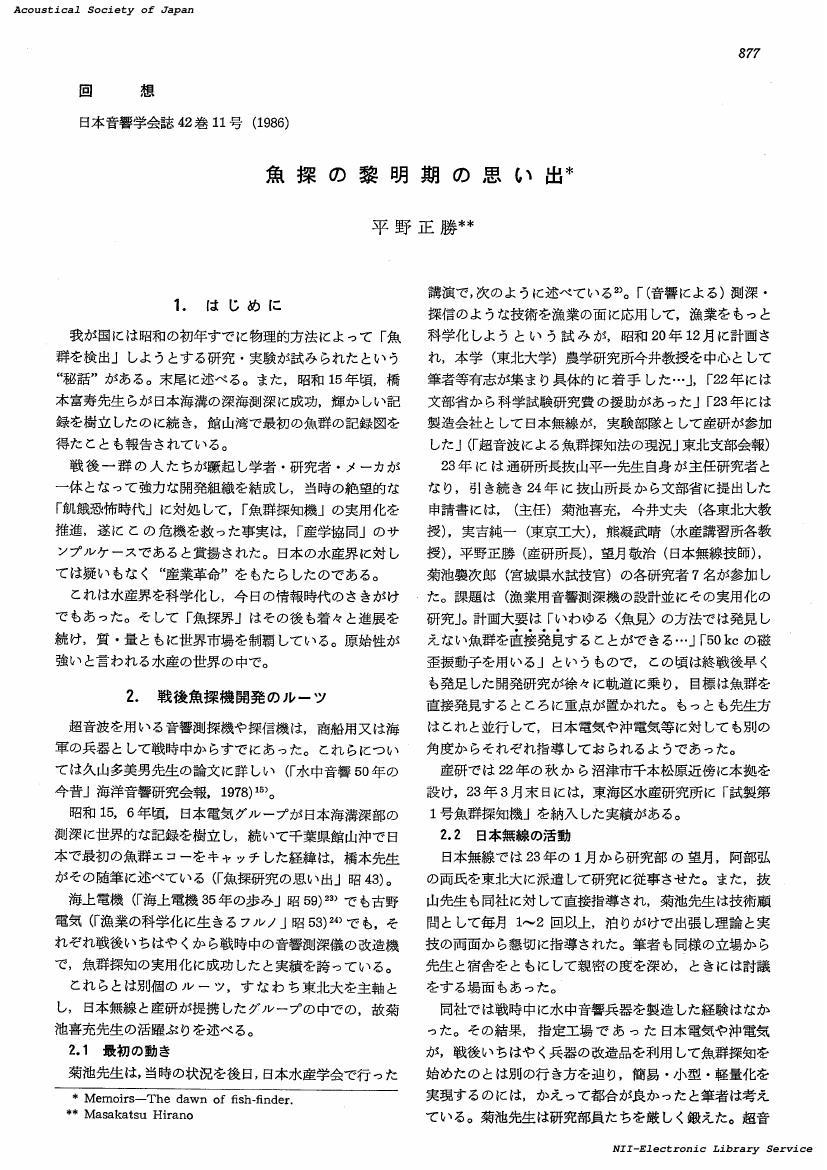1 0 0 0 OA 後十字靱帯,後方関節包損傷による反張膝の1例
- 著者
- 片岡 洋一 東海林 和弘 千馬 誠悦 平野 正史 玄 東林 阿部 利樹
- 出版者
- 東北膝関節研究会
- 雑誌
- 東北膝関節研究会会誌 (ISSN:09175164)
- 巻号頁・発行日
- vol.6, pp.23-26, 1996-07-06 (Released:2018-09-19)
- 参考文献数
- 4
1 0 0 0 OA 魚探の黎明期の思い出
- 著者
- 平野 正勝
- 出版者
- 一般社団法人 日本音響学会
- 雑誌
- 日本音響学会誌 (ISSN:03694232)
- 巻号頁・発行日
- vol.42, no.11, pp.877-883, 1986-11-01 (Released:2017-06-02)
- 著者
- 平野 正敏
- 出版者
- 交通新聞社
- 雑誌
- JR gazette (ISSN:13435620)
- 巻号頁・発行日
- vol.74, no.11, pp.10-13, 2016-11
1 0 0 0 JR東海N700A新幹線電車の概要(J-RAIL特別企画)
- 著者
- 平野 正敏
- 出版者
- 一般社団法人 日本機械学会
- 雑誌
- 交通・物流部門大会講演論文集
- 巻号頁・発行日
- vol.2012, pp.35-36, 2012
1 0 0 0 てんぷらの本
- 著者
- 平野正章 小林菊衛著
- 出版者
- 柴田書店
- 巻号頁・発行日
- 1976
1 0 0 0 一二・九運動後の学生運動と統一戦線における二つの方向
- 著者
- 平野 正
- 出版者
- 公益財団法人史学会
- 雑誌
- 史學雜誌 (ISSN:00182478)
- 巻号頁・発行日
- vol.85, no.12, pp.1613-1652, 1720-1721, 1976-12-20
The December 9 Movement was a starting point of the anti-Japanese mass movement and the anti-Japanese national united front. The students in Peking started this movement after making their own organizational and political preparations. These efforts led to the great December 16 demonstration parade and also to a movement led by the Southward Expansion Propaganda Group, which aimed at student cooperation with workers and peasants. In addition, the December 9 Movement had a great impact on students throughout the nation, as a student movement arose in every city. These provincial movements were spontaneous protests stimulated by the events in Peking. The student movement in Shanghai was markedly so, but it was overtaken by pro-Kuomintang rightist students and its main political line became the organization of the National Salvation Association. Thus the fate of its original goals was quite different from those of its counterpart in Peking. Yet, the leftist politics shown in the Southward Expansion Propaganda Movement created tension between student activists, and the average student, and so local government authorities took advantage of this chance to suppress this movement. So the sthdent movement was obliged to become dormant. However, by adopting a united front policy, the student movement recovered and came to play a role in the national united front. This policy, aimed at consolidating the student movement, consisted of forming a nation-wide student organization. Consequently there arose the Chinese Students' National Salvation Association, an organization that played a great part in forming the united front. Meanwhile the activities of the Southward Expansion Propaganda Group were taken over by the National Liberation Vanguard Group, which was very important in supporting the student movement on the grass-roots level. After the outbreak of the Anti-Japanese War it extended its activities in the provinces, playing a vital role also in strengthening the anti-Japanese National United Front and arousing local groups to participate in the effort. But, for this very reason, the student movement was suppressed by the Kuo-mintang government in August 1938 and was compelled to go into illegal underground activities. However, the student movement that had begun with the December 9 Movement not only proved to be the initiation of the Chinese People's Liberation Struggle. But also it proved to be a movement of enormous historical significance both for the formation and development of the anti-Japanese national united front and for the advancement of the unification of student groups with those of the workers and peasants.
- 著者
- 平野 正裕
- 出版者
- 地方史研究協議会
- 雑誌
- 地方史研究 (ISSN:05777542)
- 巻号頁・発行日
- vol.65, no.4, pp.52-55, 2015-08
- 著者
- 森田 茂 平野 正己 西埜 進
- 出版者
- 日本家畜管理学会
- 雑誌
- 日本家畜管理研究会誌 (ISSN:09166505)
- 巻号頁・発行日
- vol.26, no.3, pp.75-81, 1991-02-25
反すう家畜の採食行動に及ぼす飼料給与順序の影響を明らかにするため、各飼料給与時に観察された採食期(採食開始から終了まで)を採食期継続時間により分類し、採食を継続する確率および採食期回数から検討した。供試動物にはホルスタイン種去勢牛8頭を用いた。給与した飼料は、ペレット状配合飼料と細切2番刈乾草である。これら2種類の飼料の給与順序を変え、先に給与した場合(先給与)と後に給与した場合(後給与)の各飼料の採食量、採食時間、採食期回数および採食を継続する確率を比較した。1日当り採食量および採食時間は乾草において先給与の方が後給与より有意(P<0.05)に多かった。しかし、配合飼料では差は認められなかった。両飼料の採食期とも採食継続時間の分布から、採食を継続する確率の異なる4分以下の採食期(タイプA)と4分を超える採食期(タイプB)に分類された。タイプAの採食を継続する確率は、乾草での先給与の方が、配合飼料では後給与の方が高かった(P<0.05)。これに対し、タイプBの採食を継続する確率は、いずれの飼料においても先給与の方が後給与より有意(P<0.05)に高かった。各タイプの採食期回数は、乾草のタイプBでのみ有意差(P<0.05)がみられた。また、各採食期より求めた採食時間においても、乾草のタイプBのみで給与順序による差が認められた(P<0.05)。 日本家畜管理研究会誌、26(3) : 75-81.1991 1990年2月10日受理
多数例のリンパ系腫瘍の免疫表現型と免疫遺伝子型の対比検討から、一般に成熟型腫瘍では両者の良好な相関があり、T・B細胞系統性及びクローン性の確実な指標として、遺伝子型によるDNA診断の有用性が確立されたが、未熟型腫瘍では表現型・遺伝子型不一致例、また二重遺伝子型を示す例があり、腫瘍隋伴異常再構成ないし未分化幹細胞段階での不確定な細胞分化様式の可能性が示された。ことにB細胞分化の初期では有効なIg遺伝子産物産生に至るまでに、活発なIgHV、D、J領域遺伝子の再構成及び転写が行われ、就中B前駆細胞の最も分化した段階のCD20(+)c-ALLに二重遺伝子型の頻度が最も高く、この事象がcommon recombinase活性の増大によりTcR遺伝子再構成が誘発された可能性によることが示唆された。またT細胞腫瘍につき複数のprobeを用いてTcRβ鎖遺伝子再配列の様式を検討し、T-ALL、T-CLLの一部に異常再配列を認め、recombinase lovelでの誤りによる可能性が示唆された。また検索症例のなかで、Tリンパ芽球性リンパ腫から異系統の骨髄球系白血病に移行した症例で、biphenotypicであるにも拘らず、腫瘍細胞が単一細胞起源であることを分子生物学的に立証した。また我が国の悪性リンパ腫の特徴の一つである発生頻度の少ない濾胞性リンパ腫につき、特徴的な染色体異常t(14、18)の確認と、本症に特異的とされるbcl-2遺伝子再構成がmajor及びminor切断点領域ともに、欧米に比べ有意に低率であることが判明した。さらに血管免疫芽球性リンパ節症(AILD)が我が国では、Bリンパ腫よりTリンパ腫前病変の可能性が遺伝子型から同定され、ことに多様な生物活性をもつIL-5遺伝子転写の著明な増強をみるAILD-T症例を認め、当該リンパ節の多彩な病変との関連が考えられた。その他、骨髄stroma初代培養系を用いて、praーB細胞株からB細胞系及びmyeloid系へ分化誘導される培養系が確立され、またsublineからIL-5のautocrineによる腫瘍化細胞株が樹立された。

